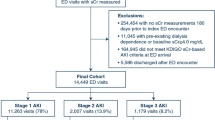Abstract
Day-care percutaneous nephrolithotomy (day-PCNL) is being performed more routinely, however, safety remains a concern. The purpose of this study was to compare the complication rate, readmission rate and medical cost saving between day-PCNL and inpatient-PCNL. A protocol for day-PCNL was applied. A retrospective review of 86 patients planned day-PCNL by one surgeon were conducted. Using propensity matching, 86 inpatients (minimum 2-day post-operative stay) treated with the same procedure were matched. For each cohort, 14-day occurrence of complications and unplanned readmissions were recorded and compared. More than 80% of patients had multiple or staghorn stones in both groups. There were no significant differences between stone-free rate, operative time, multiple-tracts use, hemoglobin drop (each p > 0.05). Day- PCNL has a higher tubeless rate (60.8% vs. 24.4%, p < 0.001) and were less costly (mean 2732 vs. 3828 dollars) compared with inpatient PCNL. Within 14 days post-operatively, 10 day-care patients (11.6%) and 13 inpatients (15.1%) experienced complications, with no difference in rate or severity. Four patients (4.6%) required full admission (longer than 24 h) and two patents needed readmission in day-PCNL group. Day-care PCNL was more cost-effective than in-patients PCNL, with no significant difference in complications along with very low unplanned readmission during the postoperative period of 14 days. Therefore, day-care PCNL is a cost-effective choice in selected patients.
Similar content being viewed by others
References
Güler A, Erbin A, Ucpinar B et al (2019) Comparison of miniaturized percutaneous nephrolithotomy and standard percutaneous nephrolithotomy for the treatment of large kidney stones: a randomized prospective study. Urolithiasis 47:289–295. https://doi.org/10.1007/s00240-018-1061-y
Jones P, Bennett G, Dosis A et al (2018) Safety and efficacy of day-case percutaneous nephrolithotomy: a systematic review from european society of uro-technology. Eur Urol Focus. https://doi.org/10.1016/j.euf.2018.04.002
Schoenfeld D, Zhou T, Stern JM (2019) Outcomes for patients undergoing ambulatory percutaneous nephrolithotomy. J Endourol 33:189–193. https://doi.org/10.1089/end.2018.0579
Bechis SK, Han DS, Abbott JE et al (2018) Outpatient percutaneous nephrolithotomy: the UC San diego health experience. J Endourol 32:394–401. https://doi.org/10.1089/end.2018.0056
Beiko D, Lee L (2010) Outpatient tubeless percutaneous nephrolithotomy: the initial case series. Can Urol Assoc J 4:E86–E90
Singh I, Kumar A, Kumar P (2005) “Ambulatory PCNL” (tubeless PCNL under regional anesthesia)—a preliminary report of 10 cases. Int Urol Nephrol 37:35–37. https://doi.org/10.1007/s11255-004-6706-9
de la Rosette JJMCH, Opondo D, Daels FPJ et al (2012) Categorisation of complications and validation of the Clavien score for percutaneous nephrolithotomy. Eur Urol 62:246–255. https://doi.org/10.1016/j.eururo.2012.03.055
Zhu W, Li J, Yuan J et al (2017) A prospective and randomised trial comparing fluoroscopic, total ultrasonographic, and combined guidance for renal access in mini-percutaneous nephrolithotomy. BJU Int 119:612–618. https://doi.org/10.1111/bju.13703
Lorenzo Soriano L, Ordaz Jurado DG, Pérez Ardavín J et al (2019) Predictive factors of infectious complications in the postoperative of percutaneous nephrolithotomy. Actas Urol Esp 43:131–136. https://doi.org/10.1016/j.acuro.2018.05.009
Margel D, Ehrlich Y, Brown N et al (2006) Clinical implication of routine stone culture in percutaneous nephrolithotomy—a prospective study. Urology 67:26–29. https://doi.org/10.1016/j.urology.2005.08.008
Koras O, Bozkurt IH, Yonguc T et al (2015) Risk factors for postoperative infectious complications following percutaneous nephrolithotomy: a prospective clinical study. Urolithiasis 43:55–60. https://doi.org/10.1007/s00240-014-0730-8
Patel N, Shi W, Liss M et al (2015) Multidrug resistant bacteriuria before percutaneous nephrolithotomy predicts for postoperative infectious complications. J Endourol 29:531–536. https://doi.org/10.1089/end.2014.0776
Wollin DA, Preminger GM (2018) Percutaneous nephrolithotomy: complications and how to deal with them. Urolithiasis 46:87–97. https://doi.org/10.1007/s00240-017-1022-x
Turna B, Nazli O, Demiryoguran S et al (2007) Percutaneous nephrolithotomy: variables that influence hemorrhage. Urology 69:603–607. https://doi.org/10.1016/j.urology.2006.12.021
Xun Y, Wang Q, Hu H et al (2017) Tubeless versus standard percutaneous nephrolithotomy: an update meta-analysis. BMC Urol 17:102. https://doi.org/10.1186/s12894-017-0295-2
Sun Y, Gao X, Zhou T et al (2009) 70 W holmium: yttrium-aluminum-garnet laser in percutaneous nephrolithotomy for staghorn calculi. J Endourol 23:1687–1691. https://doi.org/10.1089/end.2009.1536
El-Nahas AR, Elshal AM, El-Tabey NA et al (2016) Percutaneous nephrolithotomy for staghorn stones: a randomised trial comparing high-power holmium laser versus ultrasonic lithotripsy. BJU Int 118:307–312. https://doi.org/10.1111/bju.13418
Alyami F, Norman RW (2012) Is an overnight stay after percutaneous nephrolithotomy safe? Arab J Urol 10:367–371. https://doi.org/10.1016/j.aju.2012.07.006
Opondo D, Tefekli A, Esen T et al (2012) Impact of case volumes on the outcomes of percutaneous nephrolithotomy. Eur Urol 62:1181–1187. https://doi.org/10.1016/j.eururo.2012.03.010
Funding
This study was supported in part by research grants from National Natural Science Foundation of China (no. 81600542).
Author information
Authors and Affiliations
Corresponding authors
Ethics declarations
Conflict of interest
The author(s) declare no conflict of interest.
Ethical approval
All procedures performed in studies involving human participants were in accordance with the ethical standards of the institutional and/or national research committee and with the 1964 Helsinki declaration and its later amendments or comparable ethical standards.
Informed consent
Informed consent was obtained from all individual participants included in the study.
Additional information
Publisher's Note
Springer Nature remains neutral with regard to jurisdictional claims in published maps and institutional affiliations.
Rights and permissions
About this article
Cite this article
Zhao, Z., Sun, H., Wu, X. et al. Evaluation of day-care versus inpatient mini-percutaneous nephrolithotomy: a propensity score-matching study. Urolithiasis 48, 209–215 (2020). https://doi.org/10.1007/s00240-019-01160-y
Received:
Accepted:
Published:
Issue Date:
DOI: https://doi.org/10.1007/s00240-019-01160-y




